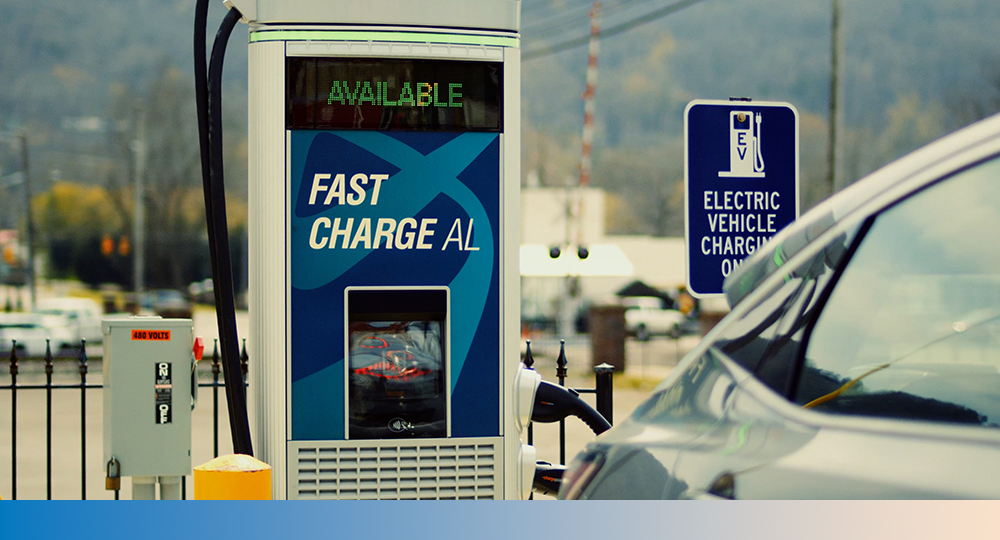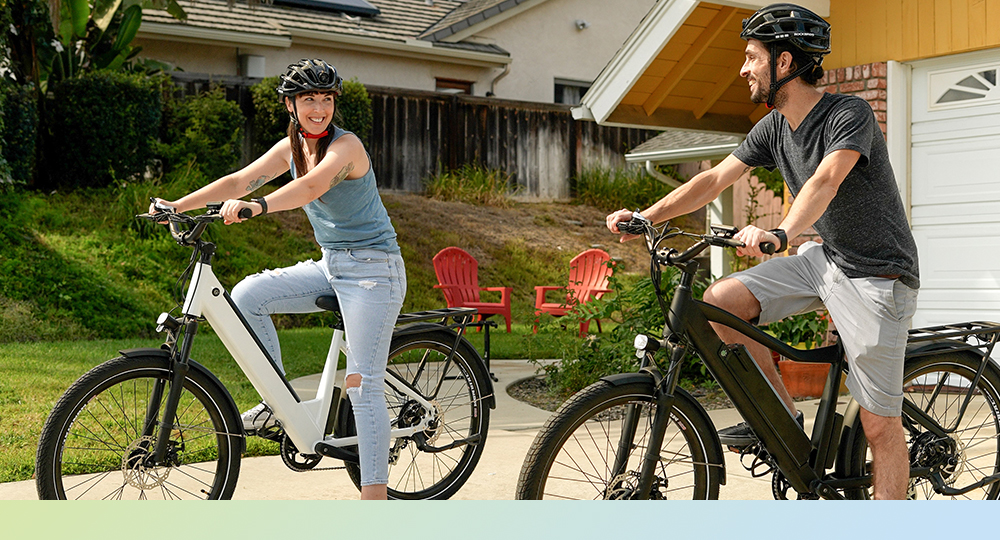How electric vehicles can help keep electricity rates low and improve grid resiliency.

A once-in-a-lifetime opportunity for change.
The rapidly growing electric transportation industry is providing us with an extraordinary opportunity to change how we think about transportation, energy costs, decarbonization and the resiliency of our electric grid.
It’s well documented that electric vehicles produce fewer greenhouse gas emissions, have a lower overall carbon footprint and produce fewer local pollutants than gasoline-powered vehicles. EVs are easier to budget for, too, because electricity rates across the country are lower and more consistent than gas prices. And with fewer moving parts and fluids, routine maintenance costs are significantly lower for EV drivers.
Big-picture data shows that more and more Americans are buying EVs. The Energy Information Administration found that U.S. sales of hybrids, plug-in hybrids and battery-only electric vehicles (BEVs) reached their highest share of total light-duty vehicle (LDV) sales during the third and fourth quarters of 2023 at 17.9%. EV sales in the U.S. increased by 60% from 1 million in 2022 to 1.6 million in 2023.
Not only that, but we’re no longer living in a chocolate-and-vanilla EV world. Today’s drivers have more shapes, sizes and flavors of EVs to choose from than ever before. Automotive manufacturers added 20 new BEV models last year, bringing the BEV total to 70. It’s worth noting that half of the new BEV models were crossover vehicles, a hugely popular market segment that has more than doubled its share of total LDV sales since 2014.
How EVs help reduce electricity costs.
With zero tailpipe emissions, lower fueling costs and lower overall cost of ownership, electric vehicles enable drivers to save money while helping preserve the environment. While this is impressive, EVs can also drive electricity costs down and improve grid resiliency. And when we say “drive electricity costs down,” we’re talking about driving costs down for everyone — not just those who refuel with electricity rather than gasoline.
Every time a new EV owner plugs in and pays for electricity, local power companies may benefit from a new source of revenue. As the number of EVs on the road — and across the Valley region — increases, so does the power company’s net revenue. This new income is reinvested in the community; it not only helps keep electricity rates low and stable, but it can also be used to pay for infrastructure upgrades that improve reliability, support local job growth and fund programs for families with limited means or fixed-income customers.
EVs apply a noticeable downward pressure on rates across the board, and a recent study from Synapse Energy Economics confirms this, finding that EVs increased utility revenues more than they increased costs.
Adjusting for utility expenditures related to EV programs, the study’s authors estimate that between 2011 and 2021, EV drivers across the country contributed $2.44 billion more in revenues than associated costs. This translates to lower electricity rates for everyone, and these findings hold true across the entire country.
Easy ways to maximize downward pressure on electricity rates.
There are several easy ways EV drivers and utility providers can maximize downward pressure on electricity rates and help lower energy costs.
#1: Charge overnight when electricity demand is low.
The best time to charge an EV is when the demand for electricity is low. In the seven-state Valley region, charging overnight is generally the best time. There is one exception to that rule, though! During winter cold snaps, avoid charging during the very coldest hours of the day.
This simple behavioral change reduces the need for TVA to generate electricity from high-cost or carbon-intensive sources — or purchase expensive power generated outside of the region. Overnight charging is an easy way for EV drivers to do their part in lowering electricity costs for everyone.
#2: Scheduled charging with networked-connected, smart EV chargers.
Most drivers don’t care when their car charges as long as it’s ready to go when they are. Networked EV chargers enable owners to schedule their EV to charge overnight, at varied times, to spread the charging load around.
Networked chargers are especially handy in areas where power companies offer discounted time-of-use or off-peak rates. If your charger doesn’t have this capability, your car probably does! Whether or not off-peak rates apply, however, networked chargers can be programmed to charge at different times throughout the night, helping keep the grid stable and balanced while maximizing any available rate discounts.
Although off-peak, time-of-day rates are far from standardized across the country, they have the potential to benefit EV owners, their neighbors, entire communities and local power companies. When people charge EVs at times when they’re not adding huge marginal costs to the utility, the power company benefits from the revenue while its customers enjoy the savings.
When power companies incentivize off-peak charging with lower rates, they effectively keep generation and distribution costs down, help customers benefit from a cleaner energy mix and reduce carbon emissions.
#3: Managed charging with smart electric vehicle supply equipment (EVSE).
Managed charging with smart EVSE presents yet another way for drivers and fleet managers to make sure that charging happens when costs are lower and the energy mix is cleaner. Not only does this lower an EV’s overall emissions, but once again, it also exerts significant downward pressure on electricity rates.
Smart EVSE units dynamically adjust the maximum power an EV will charge with. They can also automatically shift charging sessions to different times, depending on the status of the grid. This helps ensure that charging happens at optimal times. It also staggers the load, preventing accidental peaks.
Although we’re not there yet, let’s take this a step further and think about a future where we could send out a “green signal” — when renewable power is in abundance and must be used — and our cars, dryers, dishwashers and other energy-intensive devices could charge, dry, clean and cool for dramatically reduced rates.
#4: Reset the refueling mindset and right-size your charging station.
Another way to keep downward pressure on rates is simply resetting the fueling mindset to topping off, rather than filling up. In other words, drivers shouldn’t wait for the battery to dip below 20% before charging. A little bit of charging multiple times per week is far better than charging from empty to full once a week.
Topping off helps improve grid stability by minimizing energy peaks, and it’s better for the vehicle’s battery, too. Ideally, an EV’s battery level should stay between 20% and 80%. Plus, when you recharge a little at a time, the charging station can be less powerful (lower amperage) which makes installation easier and cheaper. Right-sizing your charging station saves drivers money while lessening the impact on the grid.
The news is good, and the energy forecast is bright.
The good news is that with some care and consideration, EV charging will meet customer demand and needs at low-power times of the day that are grid-friendly. This means cheaper fueling for the customer, lower power costs for their neighbors and reduced strain on the grid. It’s better for everyone, essentially. Historically, utilities have been exceptionally good at planning for and providing cheap, safe, reliable and clean electricity since the 1930s. It’s what they do.
That said, it’s a shift for utilities — big and small — because load growth has been flat for so long. It’s not anymore, and it’s not just because of changes in transportation. We’re seeing new load, building load, industrial load, data center load and more. Although it’s new to each of us, it’s not unexpected; our utilities have handled it before (think about how they rose to the challenge of electric air conditioning), and they can do it again. We just have to rise to the challenge and see the many opportunities for positive growth that EVs are affording us.
About EPRI
With a foundational mission to benefit society, EPRI delivers independent, objective thought leadership and industry expertise to help the energy sector identify issues, technology gaps, and broader needs that can be addressed through effective, collaborative research and development programs.
The TVA EnergyRight EV Team works diligently to make sure the people of the Tennessee Valley region have fact-based information about electric vehicles so they can decide how EVs fit into their lives. TVA is collaborating with state agencies, local power companies and other partners to pave the way for EV adoption in the region. This includes developing the Fast Charge Network, which will place public fast chargers at least every 50 miles along the interstates and major highways across TVA’s seven-state service area by 2026.
About our EV blogs: We know that big changes — like purchasing a vehicle that runs on electricity instead of gasoline — can lead to big questions. And that’s why we’re doing our best to provide expert, unbiased answers to your pressing EV questions. Each of our posts will include links to trusted external sources like automotive magazines, thought leaders, research-backed studies, government agencies and more. Feel free to click around!
DISCLAIMER: No TVA endorsement of any specific vehicle, car manufacturer, electric charger or other equipment is intended or implied. This site’s content (including, without limitation, references and links to third-party information) is based on information provided at the time of publishing, and TVA makes no warranty therein.



